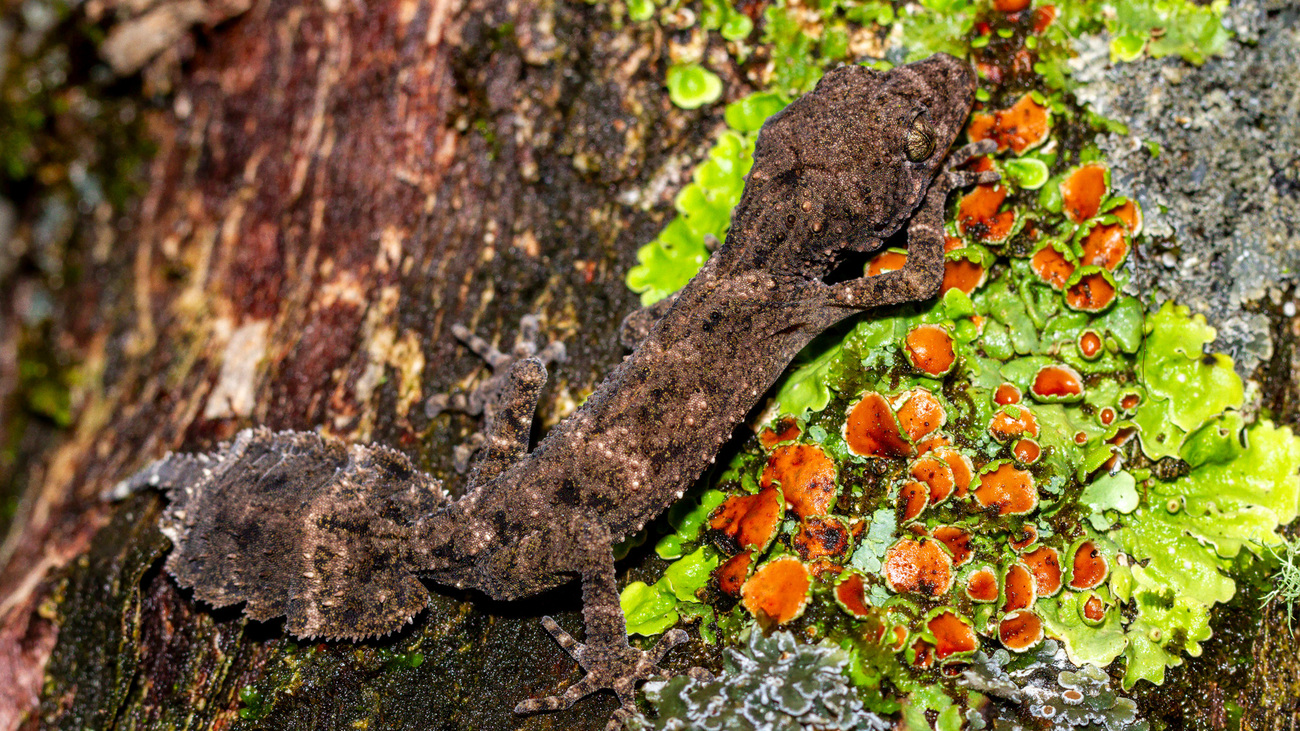Australian leaf-tailed geckos
Australian leaf-tailed geckos are nocturnal masters of camouflage. With their flat bodies and distinctive leaf-shaped tail, they blend seamlessly into their surroundings. Their impressive camouflage helps them avoid predators and ambush prey such as spiders, crickets, cockroaches, moths, and beetles.
Found only in Australia, these geckos are endemic to the country’s east coast, stretching from northern Queensland to New South Wales. Some species thrive in tropical rainforests, while others are adapted to rocky outcrops. A few, more common species, are even spotted around homes and gardens.
But their rarity and unique appearance has also made them highly sought after in the exotic pet trade. Although they are nationally protected and there is no legal commercial trade, international demand has led to trafficking of several species—some of which are now near extinction, while others face steady population declines.
On top of this, climate change is amplifying the threats. Rising temperatures, bushfires, droughts, and heatwaves are reducing suitable habitat, while urban development is fragmenting what’s left. Many species now cling to isolated patches of habitat, making survival even more difficult.
Protecting these elusive geckos means safeguarding their forests, tackling illegal wildlife trade, and taking urgent action on climate change. Their future depends on it.
Species list:
- Phyllurus amnicola - Mount Elliot leaf-tailed gecko
- Phyllurus championae - Champion's leaf-tailed gecko
- Phyllurus gulbaru - Gulbaru leaf-tailed gecko
- Phyllurus isis - Mount Blackwood leaf-tailed gecko
- Phyllurus kabikabi - Oakview leaf-tailed gecko
- Phyllurus nepthys - Eungella leaf-tailed gecko
- Phyllurus ossa - Mackay Coast leaf-tailed gecko
- Phyllurus pinnaclensis - Pinnacles leaf-tailed gecko
- Phyllurus platurus - Broad-tailed gecko
- Phyllurus caudiannulatus - Ringed thin-tail gecko
- Orraya occultus - Long-necked Northern Leaf-tailed gecko
- Saltuarius cornutus - Northern leaf-tail gecko
- Saltuarius eximius - Cape Melville leaf-tailed gecko
- Saltuarius kateae - Kate's leaf-tailed gecko
- Saltuarius moritzi - Moritz's leaf-tailed gecko
- Saltuarius salebrosus - Rough-throated leaf-tail gecko
- Saltuarius swaini - Southern leaf-tailed gecko
- Saltuarius wyberba - Granite leaf-tailed gecko
Are leaf-tailed geckos endangered?
Of the 18 species of Australian leaf-tailed geckos, the IUCN lists two as endangered (Gulbaru leaf-tailed gecko, Cape Melville leaf-tailed gecko) and two as critically endangered (pinnacles leaf-tailed gecko, Oakview leaf-tailed gecko), although many assessments were made several years ago.
Some species, including the ringed thin-tailed gecko, are listed as endangered under Australian law while others, such as the Mount Elliot leaf-tailed gecko, are listed as vulnerable under state legislation. These two species are being proposed for Appendix II protections under CITES at the 20th Conference of Parties (CoP20) in late 2025.
Threats
Australian leaf-tailed geckos face a number of threats such as habitat loss, climate change, and the exotic pet trade.
Habitat loss
Australia has one of the highest rates of deforestation in the world. Millions of hectares of land are destroyed every year by land clearing for agriculture or development, resulting in the loss of habitats for many species. Leaf-tailed geckos found in forests are increasingly losing their homes as the areas are bulldozed to make way for man-made developments.

Exotic pet trade
Australian geckos are popular and widely sought after in the reptile trade because of their rarity and uniqueness.
Climate change
Australia is experiencing an increased frequency and intensity of bushfires and heatwaves as a result of climate change. While bushfires can be catastrophic for wildlife, they also can have devastating impacts on habitats and connectivity.
The increase in these severe weather events restricts the habitat range for gecko species and threatens to make some habitats unsuitable.
How can you help?
One of the easiest ways you can help is by not contributing to the exotic pet trade—avoid keeping them as pets yourself and educate those around you on the topic. Stopping demand is the most effective long-term method of decreasing animal trade.
You can also support conservation organisations like IFAW that help protect leaf-tailed geckos and their wild habitats. Learn more about our current projects.